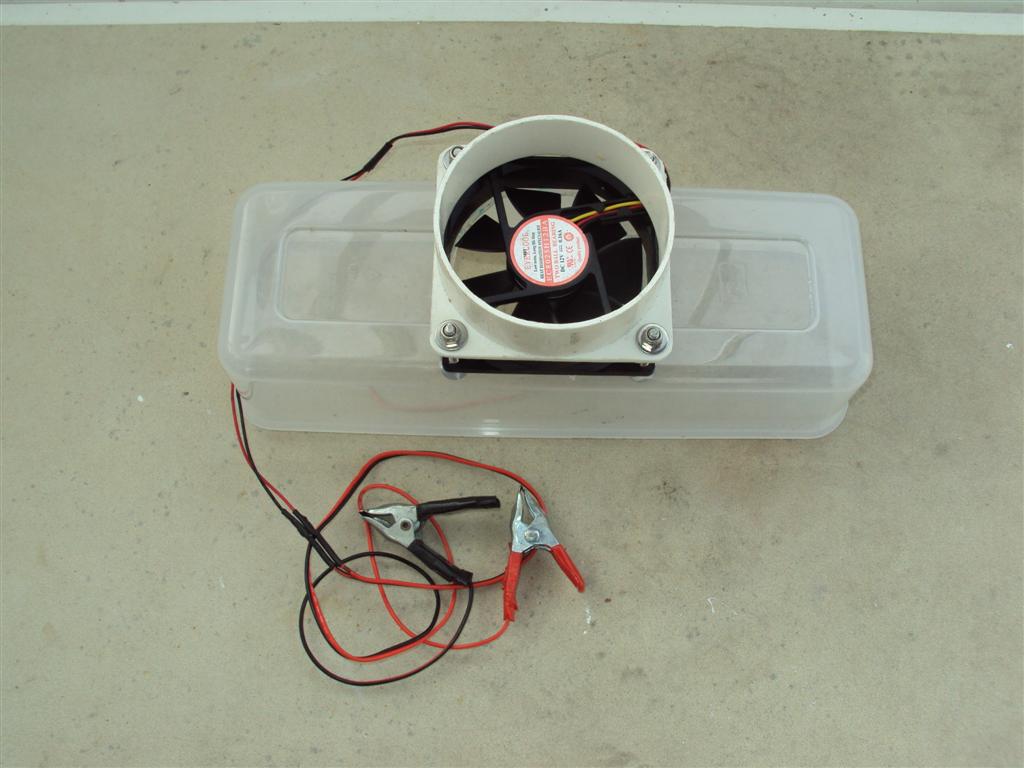SternWake
Well-known member
- Joined
- Nov 30, 2013
- Messages
- 3,874
- Reaction score
- 2
I saw these pics on a marine based forum. The guy made this battery shroud for Equalizing his batteries on his boat. EQ charges cause a lot of bubbling and offgassing, but still, This fan size is overkill for that task. Normal absorption stage charging causes much less volume of ofgasses to escape cell caps.


I can imagine a nice quiet 40Mm fan inset into such a Shroud, triggered at 14.2+ volts with a tube running outside the van body, could eliminate the offgassing issue for those sensitive to gassing batteries in the living space. With positive fan pressure, One could direct the lighter corrosive gasses down and out the floor, instead of trying to vent up and out passively.
Here's a very low amperage 40Mm fan.
6.3 cfm is more than enough, even for a pair of GC-2 v batteries being held at 16 volts for an intensive equalization charge, and it draws a miserly 0.03 amps. I have this exact fan inside my Vitrifrigo compressor fridge, for nearly 4 years now. Very quiet. runs 24/7. At 0.03 amps, one could just leave it on 24/7, or just turn it on manually during battery charging at higher charge rates which attain absorption voltage quickly, or when the battery finally reaches those higher states of charge via slower rates, and offgassing is most prevalent.
http://www.frozencpu.com/products/1...r_Wire_-_KDE1204PKV3MSARGN.html?tl=g36c15s560
So far, I'm not finding any inexpensive voltage based relays that would trigger the fan automatically at 14.2 or 14.4v ect, but will keep looking.
A nice method for hooking the 40mm fan to the still unfound exhaust tubing still escapes my googlefoo too.
Any Ideas?
I've no intention of building something like this for myself, no need, but it would be neat to be able to point some 12v rv/van dweller Newbs to a thread here, providing an easy inexpensive solution to their possible house/Auxiliary battery offgassing concerns.
Anybody want to find some plastic tupperware such item that would fit nicely over the tops of a pair of 6v GC-2 batteries and also for a standard group 27/31 12v marine/dual purpose battery?
A group 31 is ~ 13" long x 7 inches wide, and 9.25 inches tall. Group 27 is about 12 inches long same width.
A pair of 6v GC-2's needs a plastic cap a minimum of 21.5 inches long and 7 1/8th wide. I'd say 3 inches deep minimum for either cap, with more being better. Allow some space for the battery cables entry/exit, and battery tie downs.


I can imagine a nice quiet 40Mm fan inset into such a Shroud, triggered at 14.2+ volts with a tube running outside the van body, could eliminate the offgassing issue for those sensitive to gassing batteries in the living space. With positive fan pressure, One could direct the lighter corrosive gasses down and out the floor, instead of trying to vent up and out passively.
Here's a very low amperage 40Mm fan.
6.3 cfm is more than enough, even for a pair of GC-2 v batteries being held at 16 volts for an intensive equalization charge, and it draws a miserly 0.03 amps. I have this exact fan inside my Vitrifrigo compressor fridge, for nearly 4 years now. Very quiet. runs 24/7. At 0.03 amps, one could just leave it on 24/7, or just turn it on manually during battery charging at higher charge rates which attain absorption voltage quickly, or when the battery finally reaches those higher states of charge via slower rates, and offgassing is most prevalent.
http://www.frozencpu.com/products/1...r_Wire_-_KDE1204PKV3MSARGN.html?tl=g36c15s560
So far, I'm not finding any inexpensive voltage based relays that would trigger the fan automatically at 14.2 or 14.4v ect, but will keep looking.
A nice method for hooking the 40mm fan to the still unfound exhaust tubing still escapes my googlefoo too.
Any Ideas?
I've no intention of building something like this for myself, no need, but it would be neat to be able to point some 12v rv/van dweller Newbs to a thread here, providing an easy inexpensive solution to their possible house/Auxiliary battery offgassing concerns.
Anybody want to find some plastic tupperware such item that would fit nicely over the tops of a pair of 6v GC-2 batteries and also for a standard group 27/31 12v marine/dual purpose battery?
A group 31 is ~ 13" long x 7 inches wide, and 9.25 inches tall. Group 27 is about 12 inches long same width.
A pair of 6v GC-2's needs a plastic cap a minimum of 21.5 inches long and 7 1/8th wide. I'd say 3 inches deep minimum for either cap, with more being better. Allow some space for the battery cables entry/exit, and battery tie downs.













































































